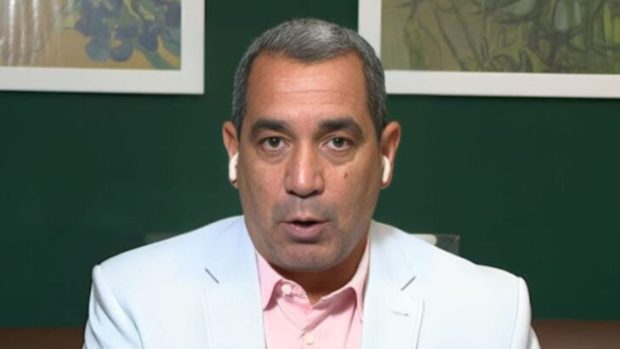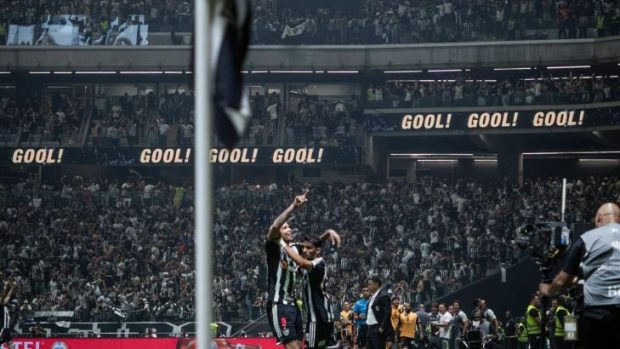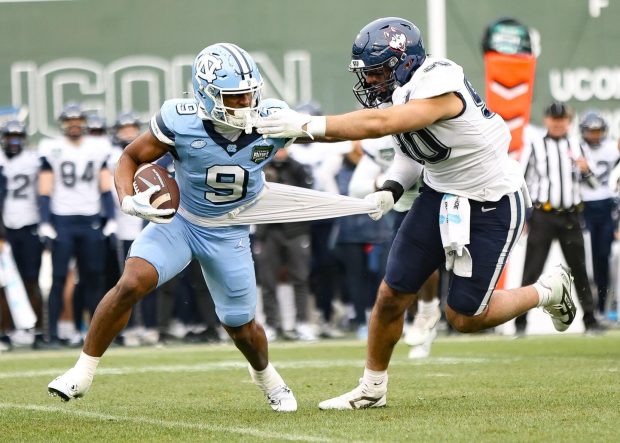Everton have played at Goodison Park since 1892, but now have one Premier League game left at their famous old home.
A move to the new stadium on Liverpool’s waterfront will follow. So, to mark the final few weeks, The Athletic has produced a series of articles and there is a special podcast to come.
This is the fourth and takes you inside what makes Goodison Park so different to the majority of modern stadiums.
You can read the first three here.
During his last trip to Goodison Park in April, Manchester City manager Pep Guardiola took some time to wander onto the pitch and soak it all in.
“I was looking up at the screen at the goals scored by players like Gary Lineker,” Guardiola would later say. “And I thought, ‘Wow, this is English football’. Now, it’s changing a little bit, but it still remains something special.”
Advertisement
Guardiola managed to perfectly capture the tone in this landmark season for Goodison. As Everton’s men’s team gear up to play their final game at their home of 133 years this weekend, players, coaches and supporters alike are seizing the opportunity to say goodbye to one of football’s most storied arenas.
Former Everton forward Richarlison did his own emotional lap of his former home — a slow, shirtless, bittersweet trudge back through memory lane — after Tottenham Hotspur’s 3-2 defeat at Goodison in January. The Brazil international has always worn his heart on his sleeve and gave the impression he would need to be dragged away.
“I feel very fulfilled for all the 83 times I’ve stepped onto this pitch where I played the most and scored the most goals in my career,” he wrote on Instagram. “Today, for the last time. Thank you, Goodison Park!”
There is something about Goodison that evokes a powerful sense of connection, even from those like Richarlison who grew up far away from the working-class part of north Liverpool in which it resides.
Going there has always been something of a history lesson.
In an age of identikit modern arenas, England’s first purpose-built stadium is one of the last of its kind — a comforting anachronism and a reminder of the days of yesteryear.
The ground exudes character. It is comfortingly old school, a relic from a bygone era and steeped in nostalgia.
In most senses, the spectator experience at Goodison leaves a lot to be desired. Wooden pillars obscure some views of the pitch. Other parts of the stadium still have wooden seats. Space is at a premium in the press box and there are only 13 corporate boxes, two of which are rented by first-team players Jordan Pickford and captain Seamus Coleman.
These are all reasons the heart-wrenching decision has been made to move to a new state-of-the-art facility in time for next season.
Yet Everton rightly remain proud of Goodison’s legacy. In many ways, the stadium tells the story of the development of English football and the global game as a whole.
Last week, The Athletic did a tour of the old stadium and went behind the scenes one final time to tell its tale.
It is fitting that we start our tour in The 1985 lounge, focusing on Everton’s greatest team and their manager, Howard Kendall.
A former Everton player turned successful coach, one of Kendall’s most famous quotes adorns the walls. “Get the ball into the box and the Gwladys Street end will suck it into the net,” Kendall told his players at half-time in their famous European Cup Winners’ Cup semi-final second leg against Bayern Munich.
Advertisement
Trailing 1-0 at the break, Everton went on to win 3-1 before beating Rapid Vienna by the same scoreline in the final.
Everton narrowly missed out on a treble that season, lifting the First Division title, but were beaten 1-0 by Manchester United in the FA Cup final at Wembley.
The club play on this history, with two gleaming trophies the centrepiece of a space which is now devoted to corporate pursuits.
From there, we head through the inner sanctum of Goodison’s Main Stand to the directors’ box. It is where key boardroom figures from Everton and their opponents sit on a matchday. There are no wooden seats or pillars here; the view of the pitch is unrivalled.

The view from the directors’ box (Patrick Boyland/The Athletic)
We are bombarded with facts about the stadium design and Goodison’s history as the first purpose-built ground in England. Goodison was the first stadium to have two tiers on all four sides and was considered an architectural triumph; so much so that in 1913, King George V and Queen Mary made a state visit.
The Park End (situated behind the goal to the left as you see it on live broadcasts) is a single-tier cantilever stand, meaning, thankfully, no posts, and was rebuilt in the 1990s.
The adjacent Bullens Road Stand, which in part houses around 3,000 away supporters, was built in 1926 and will celebrate its centenary next year.
It is there that we encounter the famous criss-cross pattern designed by the once ubiquitous Scottish stadium architect Archibald Leitch. Only three grounds — Goodison, Ibrox (home to Rangers) and Portsmouth’s Fratton Park from an original list of more than 20 still feature his iconic design.
History is important for Everton, but so too is commercial growth. We are reminded that demand has long outstripped supply at Goodison.
Alongside those 3,000 away fans in the Bullens, Everton have 33,000 season ticket holders. Given the stadium’s capacity is now a touch under 40,000, only around 3,500 seats are left.
Advertisement
Everton say they have 50,000 members and a season ticket waiting list of 30,000. The maths no longer add up.
For the famous win over Bayern in April 1985, 17,000 fans crammed into Gwladys Street (behind the goal to the right as a TV audience looks at it). The Gwladys used to be an open terrace, housing the Boys’ Pen, a caged (yes, caged) area of cheap seats. It is now two-tier and houses around 10,500 of the club’s most vociferous supporters.

(Patrick Boyland/The Athletic)
Modernisation and the government mandate for all-seater stadia in the wake of the Hillsborough disaster in 1989 have led to a significant reduction in capacity.
Everton’s record attendance of over 78,000 people came in 1948 against city rivals Liverpool, or the “other lot”, as they are known on this tour. A year later, England lost their first home international at Goodison against the Republic of Ireland.
Peaking out of the gap between the Gwladys and the Main Stand is the Church of St Luke the Evangelist.

St Luke the Evangelist church at the back of the Gwladys Street (Paul Ellis/AFP via Getty Images)
Goodison is the only stadium in the world to have a church in one of its corners, and St Luke’s remains a vibrant meeting point for supporters on matchday. The Everton Heritage Society and Everton Fan Advisory Board are based there, while the church still holds services on non-matchdays.
Everton bill themselves as the club of firsts. They champion their status as pioneers of the game with Goodison the proud centrepiece.
The list of milestones is impressive. Goodison’s Main Stand was the first three-tier structure of its type in football. The Top Balcony, at its apex, has a 48-degree gradient — one to avoid if you have not got a head for heights.
Everton were the first club to install undersoil heating and dugouts, while legendary striker Dixie Dean, who netted a record 60 league goals in the 1927-28 season, was the first player to wear the No 9 shirt. The club were founding members of the Football League and Premier League.
Advertisement
Goodison is the only English club ground to have hosted a World Cup semi-final (Wembley hosted England’s win over Portugal) as West Germany beat the Soviet Union in July 1966. The stadium played host to legends such as Pele of Brazil and Portugal’s Eusebio, the latter declaring it his favourite stadium.
The experience for visiting players now is usually far less pleasurable.
Goodison’s away dressing room is, well, basic.
There are only six showers, none of which are high-powered. Privacy is in short supply. Unlike the home dressing room, none are housed in cubicles. There are two toilets and only one urinal and work will need to be done before the women’s team move in for next season.

(Patrick Boyland/The Athletic)
The room is an L shape, which makes it harder for a manager to see all of his players during team talks. Not that the design was deliberate. Originally, it housed a big bath in the middle, but that is now gone, too.
As Premier League grounds go, it is on the less comfortable end of the spectrum. Away teams, we are proudly told, are given only hot water, tea bags and milk — the bare minimum.
Situated directly below the Main Stand, players can hear everything happening above, like gladiators waiting to enter the coliseum.

The away team dressing room (Patrick Boyland/The Athletic)
The home dressing room is notably better — rectangular, with private showers and more privacy — but still far from the height of luxury.
Our tour guide apologises for the red buzzer, located to the left of two big screen televisions, which is connected to the referee’s room. Red, of course, is the colour of fierce rivals Liverpool.

The ‘spacious’ home changing room (Patrick Boyland/The Athletic)
Roughly eight minutes before kick-off, the bell will sound, alerting the players to move out into Goodison’s narrow tunnel for their entrance to the pitch.
The big screens are used by the coaching staff to show crucial details at half-time. Everton (and England) goalkeeper Pickford sits in the far right corner and every player gets three shirts to use per game (one for each half and another as an emergency). Manager David Moyes will give a squad list to the club’s kit men on the eve of a game so they can prepare the right items.

(Patrick Boyland/The Athletic)
“Once Everton has touched you, nothing will be the same again,” reads one quote on the wall from the club’s legendary midfielder Alan Ball, a World Cup winner in 1966 with England, in the bathroom area. Key messaging appears above the sinks. “Body language. Intent. Desire”.

(Patrick Boyland/The Athletic)
The Goodison tunnel is narrow; single-file only at times.
As we head up the steps, the pre-match anthem of Z Cars blaring, and onto the pitch, there is still some confetti on the floor from the pre-match display against Ipswich Town this month, organised by supporter group The 1878s.

There are few tighter tunnels in the English game than that at Goodison (Patrick Boyland/The Athletic)
Everton installed undersoil heating in 1958 and the pitch has a camber (or slope), starting in the middle for drainage purposes.
The grass is between 4 and 5 per cent synthetic, watered every day and mowed several times a week. Everton need to inform the league and rival clubs of the chemicals they are using in case of allergies.

Goodison Park at pitch level from the tunnel (Patrick Boyland/The Athletic)
Our tour finishes in Goodison’s media suite. It is a final chance to soak up the surroundings and cram in one final history lesson.
Everton started as St Domingo’s FC, having emerged out of the methodist church of the same name. The idea was to give local parishioners something productive to do to pass the time.
Numbers swelled thanks to an influx of boys from the Everton area and the decision was eventually made to change the name.

Where Moyes and rival managers speak to the press (Patrick Boyland/The Athletic)
Everton’s first stadium was Anfield, now used by city rivals Liverpool. A rent dispute saw them leave and move to Goodison in 1892, while those who stayed behind formed Liverpool FC. The breakaway club originally tried to take the name Everton Athletic, only for league officials to scupper the idea. The names were considered too similar.
Advertisement
We are reminded by our guides that Everton won the first league title at Anfield and that Liverpool FC owe their very existence to that rent dispute. How different things would have been if Everton had stayed at Anfield.
History, eh? Goodison is full of it.
(Top photo: Getty Images; design: Eamonn Dalton)
This news was originally published on this post .










Be the first to leave a comment